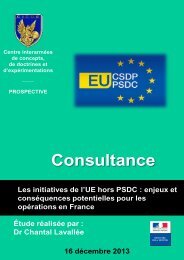Conference
science-research-bulletin-2013-conference
science-research-bulletin-2013-conference
Create successful ePaper yourself
Turn your PDF publications into a flip-book with our unique Google optimized e-Paper software.
EUROPEAN POLICE SCIENCE AND RESEARCH BULLETIN<br />
SPECIAL CONFERENCE EDITION<br />
established processes for assessment of public<br />
tension could meet just such cultural resistance.<br />
Similar approaches to the study of organisational<br />
culture have been undertaken in relation to<br />
other professions. Journalism is an instructive<br />
case, not least because of the long established,<br />
symbiotic relationship between policing and the<br />
press, and evidence in some countries of unease<br />
about its suitability for a more transparent era.<br />
In their article `Open source and journalism:<br />
toward new frameworks for imagining news<br />
innovation’, Lewis and Usher (2013) identify the<br />
new phenomenon of the programmer journalist,<br />
a wholly new category from early models of the<br />
computer-aided reporter. These programmerjournalists<br />
aim to produce not stories but<br />
filters for information. They become curators<br />
of the world of user-created content, they<br />
manage public debate rather than looking for<br />
scoops. Their values are those of transparency,<br />
iteration, tinkering and participation, rather than<br />
exclusivity. In order to try to establish whether<br />
this challenge to the established world of news<br />
reporting actually exists, Lewis and Usher<br />
analysed a large sample of journalists’ blogs to<br />
look for evidence of journalists deviating from<br />
their role as nonpartisan information providers<br />
by expressing personal opinions; sharing their<br />
gatekeeping role by including postings from<br />
others in their microblogs; providing a semblance<br />
of accountability and transparency to their<br />
professional work by offering their audiences<br />
links to external websites that background the<br />
information they provide.<br />
The conclusions are disappointing for the<br />
innovator, if predictable. Lewis and Usher find<br />
that while journalists and technologists are<br />
working together to bring open-source tools<br />
into the newsroom, this hasn’t challenged old<br />
processes of news work or old news values. New<br />
tools are used to help journalists do what they<br />
have always done. Newsrooms have been quick to<br />
impose social media ethical guidelines; instead of<br />
experimenting with how audience participation<br />
might change the journalism conversation, news<br />
institutions have tended to retrofit yet another<br />
reporting tool.<br />
The alternatives are not easy though —<br />
annotative journalism; journalism as knowledge<br />
management, with journalists as curators of<br />
the collective knowledge. This is borne out by<br />
studies of how journalists use Twitter as well.<br />
Twitter alike show journalists reluctant to give up<br />
their gatekeeping role and engage in ‘ambient<br />
journalism’ (Lasorsa et al. 2011).<br />
Why is this of interest for policing? Because while<br />
there is a hypothesis that hierarchical, command<br />
and control police culture and organisation<br />
is at odds with the openness of the world of<br />
user-generated content, it is not clear what the<br />
resolution of this means in practice. As for the<br />
journalists investigated by Lewis and Usher,<br />
there has been extensive work in the creation of<br />
guidelines and codes of practice. There has also<br />
been disciplinary action on the basis of those<br />
codes against individual officers. But I don’t think<br />
we have a systematic, as against an anecdotal,<br />
view of the ways in which social media, both as<br />
a source of information coming into forces or<br />
as a means of communicating outwards from<br />
them, has had an impact on power relationships<br />
and organisational structures. Is it, as in the<br />
journalism examples, a tool for doing established<br />
work better, or is it the basis of a wholly new way<br />
of working?<br />
In the intelligence community, one of the<br />
responses to 9/11 was the publication of an<br />
article by Calvin Andrus (2005), from the CIO’s<br />
office in the CIA ‘The wiki and the blog: towards<br />
a complex adaptive intelligence community’.<br />
Andrus identified the need for bottom up<br />
approaches and compressed response times,<br />
and saw social media tools as the way to achieve<br />
that. These now include A-Space, Intellipedia and<br />
TAG|Connect but one could also suggest that the<br />
kind of networked analytical tools offered by i2<br />
and Palantir import similar, if more structured,<br />
approaches. (Werbin 2011)<br />
Police forces have begun to develop similar<br />
knowledge management systems — e.g. the<br />
Police Online Knowledge Area POLKA in the UK.<br />
The research challenge is to know how they are<br />
changing the way information is created, owned,<br />
used and conceptualised in forces.<br />
4. OPPORTUNITIES<br />
The impact of social media on policing is still a<br />
relatively new phenomenon. For the research<br />
community, the time since police forces began to<br />
use social media is little more than a single cycle<br />
of grant application, data collection, analysis,<br />
peer review and publication ago. During that<br />
time, social media themselves have evolved in<br />
111





